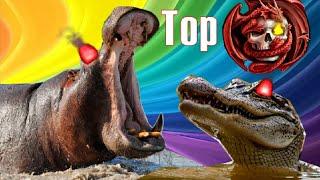10 Most Unusual Animals in the World
Description
10 Most Unusual Animals in the World
The world is not only populated with boring dogs and cats you know. Today we will look at 10 of the
most unique and unusual animals in the world. Make sure you stay tuned for number one. That animal is
positively psychedelic.
Number 10. The Saiga Antelope
Looking like a deer that desperately wants to be an elephant, Saiga antelopes are one of the most
ancient mammals, having shared the Earth with saber-toothed tigers and woolly mammoths. At that
time saiga inhabited a vast territory ranging from the British Isles to Alaska. Immense herds of saiga,
numbering in the tens of thousands, once roamed the steppe landscape. This evolutionarily unique
animal, the only species in the genus Saiga, has cultural and historical significance for the people of
Central Asia as a symbol of the traditional nomadic lifestyle.
Although they have survived for millennia, these animals face extinction today. In the spring of 2015, a
mysterious disease wiped out more than half of the species' remaining population on Earth. More than
200,000 saiga antelope perished during the mass die-off in Kazakhstan, the bodies of adults and calves
dotting the grasslands for miles.
After careful study of animal remains from the die off, scientists have concuded the saiga were killed by
hemorrhagic septicemia, or fatal blood poisoning, which was caused by Pasteurella multocida type B
bacteria, which lived and multiplied in their noses. Who knew that the thing that made them so unique
would also be the cause of their downfall?
Number 9. Sloan’s Viperfish
This deep sea fish has fangs so large that they protrude from its mouth, sitting like spears alongside its
beady eyes. Lurking at between 1,000 and 2,000 meters below the surface of the ocean, the viperfish
uses bioluminescence to create a small lamp that dangles from its back to attract its prey of crustaceans
and small fish.
In spite of its ferocious appearance, the viperfish is a relatively small animal, growing to about 30
centimeters in length. It is usually dark silvery blue in color, but its coloration can vary from green to
silver or black. Although the main light organ is located at the end of the elongated dorsal fin ray, there
are also several photophores located all along the side of the fish. These may help to camouflage the
fish from predators lurking below. These lights make its bottom side appear to blend in with the
extremely faint light filtering down from above. They may also serve to attract prey and communicate
with potential mates or rivals.
Although viperfish have been known to get caught up in deep sea trawlers' nets, it is unlikely that you
will ever see a living specimen. However, they may be spotted at Iceland's annual Festival of the Sea at
Reykjavik harbor, at which fishermen display a variety of strange, deep-sea species, including sea
lampreys, fangtooths and viperfish.
Number 8. The Bald Uakari
South Americans reputedly nickname this poor bald monkey 'mono angles', or 'English monkey', in
honor of the first sunburnt Britons to visit their homeland. Whether or not that's myth or reality, the
bald ukari's scarlet pate does resemble that of a holidaymaker who has fallen asleep in the sun. During
the rainy season, this vulnerable species lives high in the tree tops of the Amazon river basin, but
retreats closer to the ground in the dry season to forage for nuts and seeds.
It's most easily recognized by its red face and bald head; from which it derives its name. Some people
compare them to old men and babies, because of their baldness; there is no denying this species is
uniquely handsome. The striking crimson color is caused by blood-flow beneath the skin, specifically a
thinner epidermis coupled with a higher concentration of capillaries in the face. The redness of a
female’s face is correlated with her estrogen levels; the redness of a male’s face is indirectly related to
his testosterone levels, according to a recent study. A redder face indicates a healthier monkey, since
their faces, like ours, grow pale when they’re ill—particularly with malaria, which is rampant in their
habitat.
Number 7. The Lowland Streaked Tenrec
Madagascar is home to quite a number of unique and weird creatures. But with regard to looking weird,
this next anima on our list truly takes the cake.
If you're new, Subscribe! → http://goo.gl/djmfuX
Top 5 Best is the #1 place for all your heart warming stories about amazing people that will inspire you everyday. Make sure to subscribe and never miss a single video!
Leave a like for more shark tank, pawn stars, dr. phil, and other tv show business content. On Top 5 Best, we like to help you in mindset productivity, whether it's how to make more money videos, or going over the biggest mansions in the world, we show everything here! Make sure to subscribe for more amazing videos everyday!
family friendly pg clean
#viralstory #amazingpeople #top5best





















Comments